IDEX Online Research: November U.S. Jewelry Sales Strong
January 25, 07 by Ken Gassman
U.S. jewelry sales have been on a roller coaster ride all year, and in November, the track headed upward. For November 2006, specialty jewelers’ retail sales in the U.S. advanced by 6.7 percent. This was up from October, when jewelers’ sales rose by 6 percent (revised). However, November’s sales gain was below the year-to-date increase of 8.5 percent, and it was below the trailing twelve-month sales gain of 7.9 percent.
Most of the jewelry demand in November came late in the month. Jewelers said that sales spiked around the Thanksgiving period, which is the traditional kick-off date for the holiday selling season. Factors that drove jewelry consumption included seasonally low gasoline prices, low heating bills due to the mild winter across most of the country, a strong labor market, solid wage gains, and the prospects for large year-end bonuses, many of which were to be paid in early December.
The graph below compares U.S. jewelry sales gains to all retail categories, ex-automobiles.
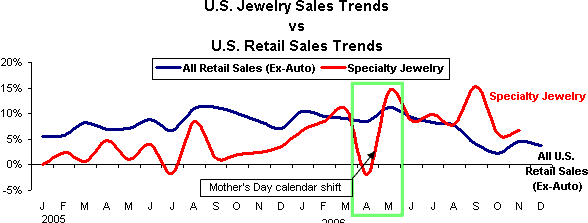
Source: U.S. Dept. of Commerce |
In addition to solid economic and consumer fundamentals, jewelry sales gains in November 2006 benefited from easy comparisons in the prior year (see graph above, red line). Jewelry demand in the U.S. sagged in September 2005 due to several Gulf storms that took the wind out of consumers’ sales. For the balance of 2005, jewelry demand remained weak in the U.S., in dramatic contrast to total retail sales (graph above, blue line).
November Total Retail Sales Show Upturn
While total U.S. retail sales in November 2006 were soft – up just 4.6 percent, which was below its year-to-date trend of +7.6 percent – they showed a rebound from October’s very modest gain of +2.3 percent. In November, merchants reported strong sales of consumer electronics and building supplies. However, these gains were offset by weakness in demand for furniture, general merchandise, and apparel.
December Preliminary Figures Suggest Weakness
The U.S. Department of Commerce has reported preliminary U.S. retail sales for December 2006, and initial indications show that consumer demand was weak. After rising 4.6 percent in November, preliminary retail sales (ex-auto) were up just 3.8 percent in December. While consumer electronics sales remained strong, most other categories were weak. Economic and consumer fundamentals remained solid in December, but it seems that holiday shoppers either ran out of steam earlier this year, or they were waiting for even bigger price discounts in January.
A preliminary canvas of U.S. specialty jewelers shows that December sales were “mixed,” with guild jewelers reporting satisfactory sales gains, but mass market jewelers reporting weak gains.
Next month, IDEX Online Research will publish a full recap of holiday jewelry sales. The table below summarizes sales results of the publicly held jewelers.

Source: Company Reports |
Luxury Demand Strong
While preliminary U.S. retail sales were weak in December, luxury goods sales strengthened. This reflects shoppers’ desire for high quality luxury goods, a trend that has characterized the market for the past year or more. Unfortunately, the correlation between jewelry demand and luxury goods demand is only moderate. Thus, we are unwilling to make a prediction about December jewelry sales trends based solely on the performance of other luxury goods retailers.
The graph below compares jewelry retail sales with retail sales of luxury goods.
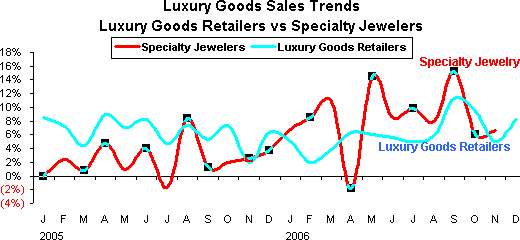
Source: Dept of Commerce & ICSC |
Mall Jewelry Sales Gains Lag
Mall jewelers’ sales gains sagged in the spring of 2006, and there has been no recovery since then, except for a sales spike in September that was created by a mathematical aberration (easy comparisons to September 2005 when a series of natural disasters severely depressed jewelry demand). IDEX Online Research believes this weakness in mall jewelry demand is due to two factors: 1) weak mall traffic and 2) weakness among mass market jewelers, most of whom are located in malls. In contrast, guild jewelers are generally reporting stronger sales, but these higher-end jewelers typically have off-mall store locations.
The graph below compares jewelry sales of mall merchants versus specialty jewelry merchants.
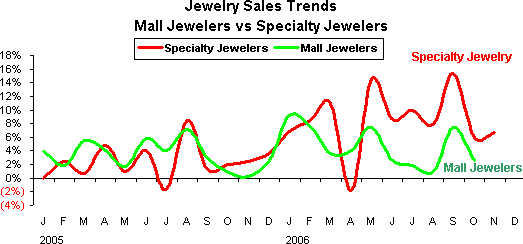
Source: Dept of Commerce & ICSC |
Specialty Jewelers Lost Market Share in November
Last month, IDEX Online Research introduced a new measure of jewelry sales in the U.S. We are now able to compare specialty jewelers’ sales to all jewelry sales. In the U.S., there are about 128,000 doors selling jewelry, of which there are about 28,000 specialty jewelers. The balance of these 100,000 retailers represent non-specialty jewelers, including mass merchants such as Sears and Kohl’s, discounters such as Wal-Mart, and all others who sell jewelry. Roughly 47 percent of all jewelry purchased (by value) in the U.S. is sold by specialty jewelers such as Kay and Zale; the other 53 percent is sold by other non-specialty merchants.
In November, total U.S. jewelry sales rose by 8.6 percent, well ahead of the sales gain posted by specialty jewelers of 4.6 percent. As a result, specialty jewelers lost market share to other merchants who sell jewelry. In part, this is to be expected during this time of year. Shoppers are already in the discounters looking for gifts; they see jewelry in those stores and make an impulse purchase. The same trend occurred in 2005.
The graph below compares specialty jewelers’ sales trends to total jewelry sales trends.
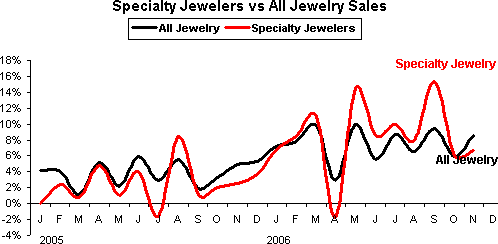
Source: IDEX Online Research |
Outlook for Jewelry Sales: Moderate Gains
The holiday selling season is over, and most jewelers say their results were acceptable. Better-end retailers posted stronger gains than mid-level merchants.
In 2007, the economy is expected to slow, both in the U.S. and globally, with some notable exceptions in Asia where the regional economy continues to boom. Historically, there has been a high correlation between economic trends and jewelry demand. When the economy is posting solid growth, jewelry sales soar. When the economy slows, jewelry demand plummets.
In 2006, it appears that U.S. jewelry sales will rise by a strong 7 percent or so, driven largely by price inflation. For 2007, IDEX Online Research is forecasting that U.S. jewelry sales will likely rise by a more moderate 3 to 4 percent for the year, barring new inflationary pressure.
IDEX Online Research’s Proprietary Jewelry Sales Forecast Steady
The IDEX Online Proprietary Jewelry Sales Forecast model has moved around like a yo-yo in 2006. This is a mathematically-driven model, which has no qualitative inputs. While we usually comment about our confidence in the model’s direction, we don’t “cook the books” with our opinions.
Currently, the forecast model is calling for 2006 U.S. jewelry sales to be up about 7 percent. That is in line with our preliminary forecast, which draws on this model as well as a sample of results from retailers across the nation. Historically, the mathematical forecast model has been accurate, though at times we have been skeptical. In the end, though, it usually nails the number, as it appears to have done this year. Jewelry sales in December represent nearly one-fourth of the industry’s total annual sales, so final results are heavily influenced by December sales. Thus, we reiterate: our forecasts are preliminary, but it appears that U.S. retail jewelry sales were up about 7 percent in 2006.
The graph below summarizes IDEX Online Research’s jewelry sales forecast for the U.S. market in 2006.
| 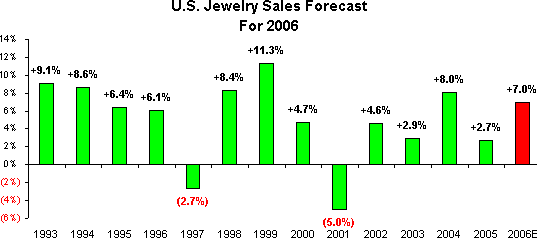
Source: IDEX Online Research
|






